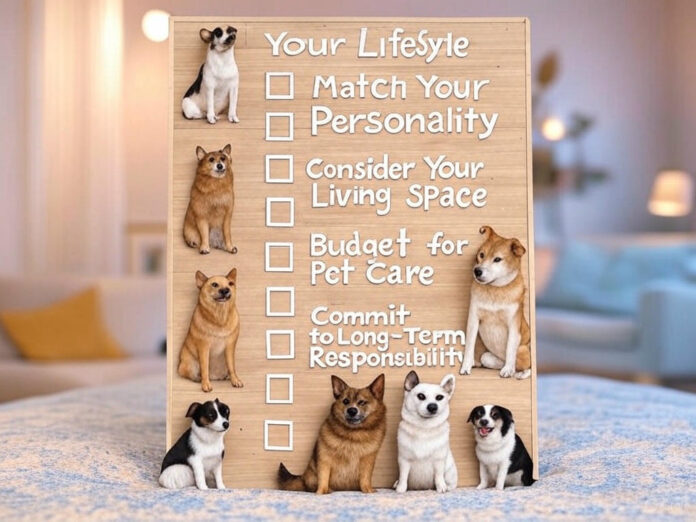
Choosing a pet is a life-altering experience that brings love, companionship, and responsibility—or so goes traditional wisdom. With several animals to choose from—dogs, cats, birds, rabbits, and others—finding one that suits your personality and lifestyle may be a matter of consideration. This article will take you through an enlightening thought process, guiding you to choose a pet that effortlessly fits into your environment. Mapping your daily activity, personality traits, living situation, budget, and term of commitment will set you up well to welcome a furry (or feathered) friend that would just do wonderfully for you. Now let’s set off on this incredible journey with your handy 5-step checklist!
Step 1: Assess Your Lifestyle and Daily Routine
Your lifestyle is the foundation of your pet selection. Are you an active adventurer enjoying mountain hikes, or are you a couch potato loving evenings in? Your routine will be at the core of choosing a pet that will be happiest with you.
- High-Energy Lifestyles: If you are off on the move now and then, you would want a dog that loves exercise, say, a Labrador Retriever or Border Collie. These breed kinds will thrive on activity, matching your idea of outdoor fun.
- Relaxed Lifestyles: If peaceful evenings are your thing, maybe a cat or small animal like a hamster should fit your best choice. Cats are independent and can care for themselves, and hamsters need little space and attention.
- Time Availability: Be honest with yourself when it comes to time available for pet care. A dog requires regular walks and playtime, while reptiles like turtles require little attention, but specific care is needed.
Action Tip: Make a list of your weekly schedule. Jot down all the hours you spend at home, your exercising habits, and your travel frequency. This will help you narrow down pets that fit well in your routine.
Step 2: Your Personality and Its Compatibility With a Pet’s Temperament
Your personality is a very important aspect of pet compatibility. Each pet has its own temperament, and finding one complementary to your vibe can develop a harmonious bond.
- Outgoing and Social: On the other hand, extroverts naturally love the company of a playful dog like a Golden Retriever or a vocal parrot that loves to interact. Such pets thrive on attention and require extra energy to keep them busy.
- Calm and Reflective: A cat or even a gloriously calming aquarium relieves some introverts’ needs of companionship without constantly demanding interaction.
- Adventurous and Curious: Ferret or hyperactive dogs’ breeds such as Australian Shepherds can keep pace with your freedom spirit.
Action Tip: Go online for a quick personality quiz (or simply reflect on your own characteristics). Are you patient? Energetic? Nurturing? Compare these traits to behaviors of pets with which you’d be most compatible.
Step 3: Consider Your Living Space
The home environment plays a vital role in pet selection. Whether you’re living in a big house or a small apartment, there is a pet that fits your situation.
- Tight Spaces: Cats, small dogs (Chihuahua), or caged pets like birds and guinea pigs are best suited for apartments or rented flats. These creatures do not require much space to roam.
- Large Spaces: If you have a yard, bigger dogs or even outdoorsy types of pets such as chickens may be an option; they’ll use the extra space for frolicking and sniffing.
- Pet Restrictions: Landlords or homeowners’ associations may impose restrictions that disallow certain breeds or types of pets. Some places allow only small pets or impose weight restrictions on dogs.
Action Tip: Measure your living space and look for space requirements for pets. For example, a Great Dane needs more space than a Betta fish. Make sure your home can cater to your pet’s needs.
Step 4: Budget for Costs Associated With Pet Care
From food and grooming to veterinary visits and equipment, life with a pet is a financial consideration. Drawing up a budget will also ensure that you provide a long, good life for your new friend.
- Initial Costs: Adoption fees, crates, bedding, or tanks will need to be considered. Setting up the fish aquarium can cost $100–300. Meanwhile, setting up a dog’s supplies will vary widely.
- Regular Costs: The costs of foods, toys, and grooming will apply to just about any pet. In general, cats and small animals cost less, whereas dogs and exotic pets (such as reptiles) may need particular care.
- Emergency Funds: Unexpected illnesses can rack up larger vet bills. Think about getting pet insurance or starting a savings plan for emergencies.
Action Tip: Draw up an approximate monthly pet budget. Research average pet care costs for your top pet contenders (e.g., $50/month for a cat vs. $100+/month for a dog) and settle your choice on a pet that places you in financial comfort.
Step 5: Make Sure You Commit for a Long-Term Responsibility
Pets are long-term responsibilities; they often survive 10–20 years or longer. Make sure that you are up to this adventure by looking into your life one step ahead with respect to plans as well as ability to care for a pet.
- Expected Lifespan: Dogs and cats generally live to be around 12–18 years, while parrots or turtles can extend their lives for decades. Choose a pet whose longevity fits into your long-term plan.
- Life Changes: If you are moving or changing jobs or thinking of family plans, will you have time for a pet? A kitty might fit better with your pending life changes, while a dog will be very demanding of your time.
- Training and Care: Some pets need training (puppies) or constant care (goldfish) of varying degrees of complexity. Be prepared to set aside time to learn about their needs.
Action Tip: Put down your 5-year plan. You must question your availability of time, space, and resources for a pet. Otherwise, this would suggest a low-commitment pet like fish or cold-feeding it as a way to measure if having a pet would work for you.
Why the Importance of Choosing the Right Pet Means So Much
Selecting a pet that matches your personality and lifestyle is a silent assurance of a long-standing and pleasurable partnership. A well-suited and harmonious pet will often help reduce stress, brighten life, and create unforgettable moments. An example would be that walking an active dog forces one into exercise, while the soft thud of a purring cat acts as a great balm at the end of an excruciatingly long day. With this further 5-step checklist, you will hammer the blueprints squarely to ensure your success as a pet parent.
Newbie Pet Owner Tips
- Research Breeds and Species: Even among species, personalities differ. A very vocal Siamese versus a very quiet Persian, for example.
- Adopt, Don’t Shop: Shelters have lots of wonderful pets that need homes. Adoption saves lives and often means first-time veterinary care.
- Start Small: As a beginner pet owner, you can try to start with an easy pet like a betta fish or hamster. This will be a good introductory confidence builder.
- Connect with Community: Online forums and local pet groups are places to join and learn about caring for pets while finding moral support. Pet parenting can be so much more enjoyable when experiences are shared.
Are You Ready to Find Your Ideal Pet?
It’s an exciting journey to choose a new pet, and it starts with understanding yourself well. Identify your lifestyle, personality, living space, budget, and commitment level, and you’ll find a companion who ensures you a lifetime of joy—be it a faithful dog, a cuddly cat, or a quirky bird. Your perfect pet is waiting somewhere out there. Start by making a checklist, heading to the shelter, or searching online. Your new best friend is closer than you think!
Call to Action: Share your experience with pet choosing in the comments or on social media with #PerfectPetMatch. Let us inspire others to find their best-suited companion!






